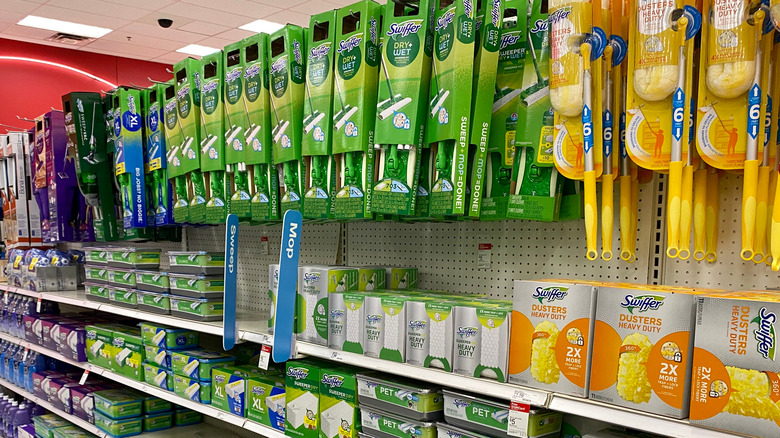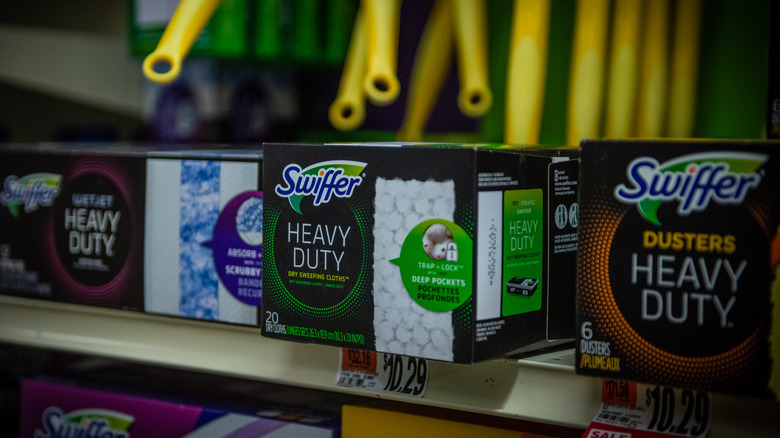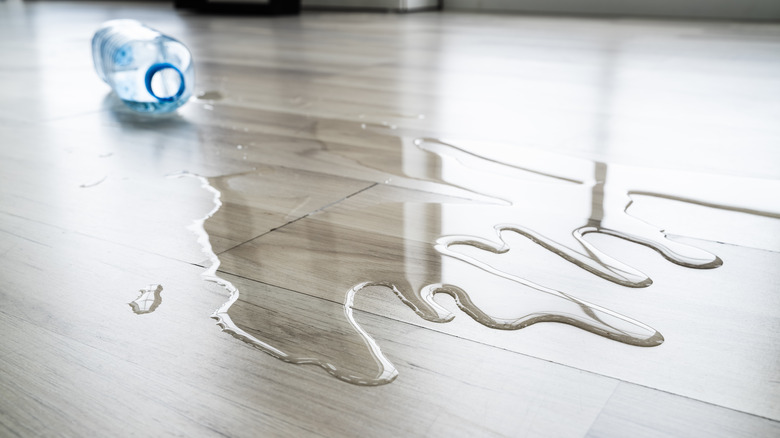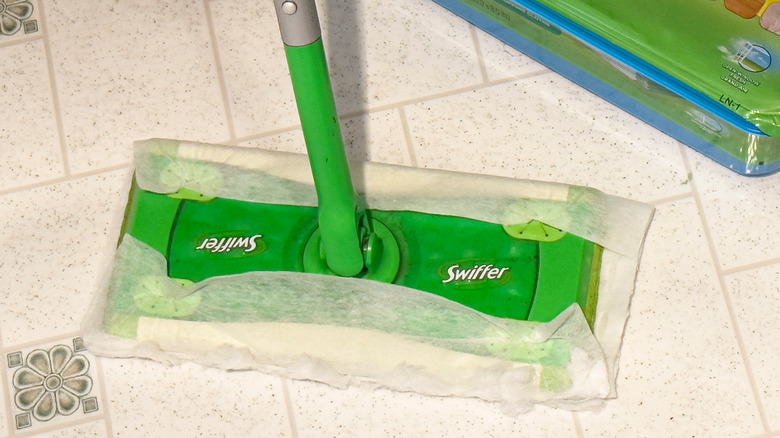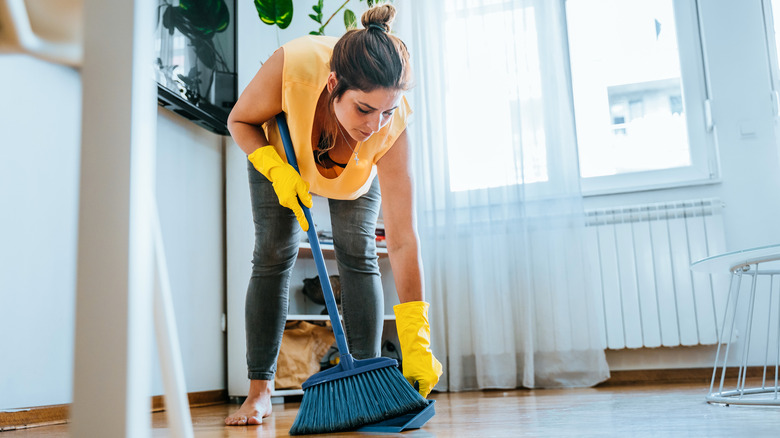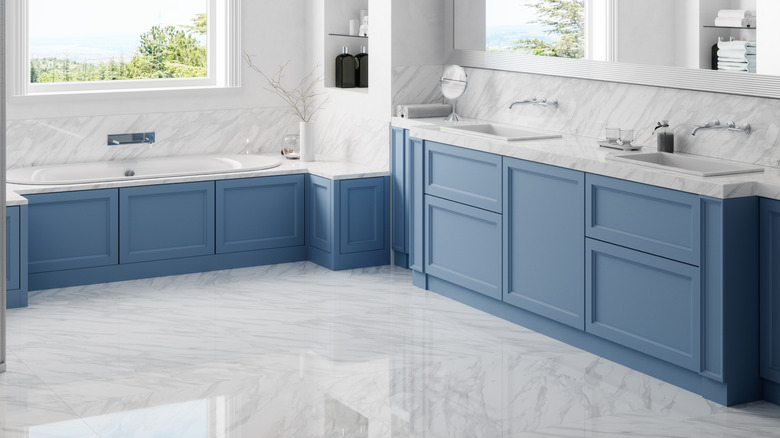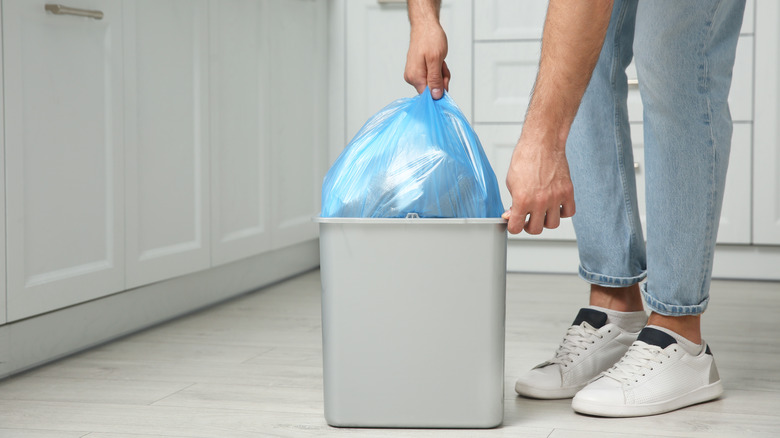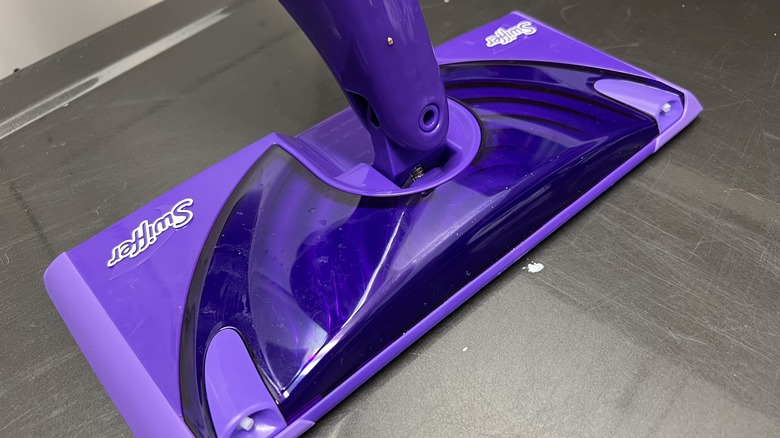Sneaky Drawbacks You Need To Consider Before Buying A Swiffer
We may receive a commission on purchases made from links.
Keeping the floors clean can be one of the most challenging things to keep up with. So, ensuring you have the right products to get the job done quickly and efficiently is key. Swiffers are popular among many homeowners for their ability to sweep and mop using only one tool. Rather than storing a bucket, mop, and broom, the tool offers a sleek design that you can fit nearly anywhere in your home. However, Swiffers also come with their own set of disadvantages, such as cost, and some other features that aren't for everyone.
The cleaning brand offers several products, including the Swiffer Sweeper, which comes with a handle and requires refillable cleaning cloths. Swiffer aims to cut down the time it takes to get a thorough clean and do a better job than standard brooms and mops. And, there's no denying the pros, like easier storage and less mess. However, here are some drawbacks to consider before buying a Swiffer.
Swiffers can be more expensive
When you use a broom and mop, it typically comes with everything you need. Some brands may be costly, but you shouldn't need to replace them often or purchase anything additional. When using the Swiffer, you'll need to continue spending money to use it, making it more expensive in the long run. You must regularly purchase both dry and wet pads if you're using a Swiffer to tackle sweeping and mopping your floor.
The refillable mop pads range from about $0.45 to $0.67 each on Amazon. And, each dry sweeping cloth will cost you a little over a quarter. While this doesn't sound like a lot, it can add up rather quickly. If you have a large home with all hard flooring, you may go through a few boxes each time you clean. Additionally, for more expensive Swiffer products, like the WetJet, you'll need to purchase their cleaning liquid, which costs about $13 at stores like Walmart.
Swiffer pads aren't ideal for big messes
Between pets, kids, and daily life, you're sure to spill something on your floor at some point. If you accidentally spill a bottle of water or cup of coffee, Swiffer may not have what it takes to get the job done. Even the Swiffer WetJet Heavy Duty mop pads are less than a quarter-inch thick, so you can only absorb so much before replacing them. As they become saturated, they will just begin to push around the spilled liquid rather than soaking it up, leading to a bigger mess.
Changing out the soaked pads for a big clean-up can be messy, costly, and time-consuming. On the other hand, a typical mop is designed to absorb a sizeable amount of liquid with relative ease. If you still want the convenience of a spray mop, the Bona Mop's pad is double the thickness. With half an inch of layered microfiber, it can be a better option to tackle sizeable spills.
The Swiffer is less durable than other options
Initially, you may look at a Swiffer Sweeper price tag and think it's relatively inexpensive. And while the Swiffer maneuvers somewhat well, the mop's construction may not be ideal for durability. Plus, cleaning up tough spots requires a bit of forcefulness to get out. Pushing too hard or aggressively could easily cause the pole to break, explains the company's safety warnings.
WetJet Mop reviewers only give the product 3.3 out of 5 stars in terms of product quality. One reviewer says, "Where the handle and the pole meet is so weak. As you use the item it bends and folds so it isn't even strong enough. This product is not made to last."
This could be the reason why Swiffer offers a much shorter warranty than some of its competitors. The company covers the product for just one year. However, Bona and Casabella, two similar mopping tools, come with five-year guarantees.
You may need to sweep or vacuum before you use your Swiffer
One mistake many Swiffer owners make is relying solely on the cleaning pads to pick up all the dust, dirt, and hair. Unlike standard brooms, Swiffer pads use electrostatic cling, or static electricity, to cause pieces of dust, dander, and hair to latch onto them. While this is a great tool to have to gather smaller particles, it's not meant to grab onto chunks of dirt or large dust bunnies that have piled up. Instead, a Swiffer would grab what it could and push the rest around your floor. By sweeping or vacuuming before you use your Swiffer, you can get the bulk of the dirt first, then Swiffering to get any excess the vacuum or broom couldn't.
Although you can vacuum after Swiffering to ensure everything is cleaned up, it's not as efficient. Not only will the Swiffer not grab everything, but it could also speed up your pad's life. And of course, this adds an extra step, making your floor cleaning process less efficient.
The Swiffer WetJet solution isn't suitable for delicate surfaces
Swiffer boasts about the WetJet's ability to clean virtually any floor in your home. However, it's not suitable for them all. Delicate surfaces like marble require special care, like quickly cleaning spills, sealing regularly, and using products with certain pHs.
Carol Smith, the owner of Hire A Maid, tells Readers Digest, "Because the Swiffer Wet Jet has a pH level of ten, making it alkaline, it isn't suited for any delicate surfaces like marble that require a neutral six to eight pH cleaner."
Instead, you can use products you likely have around your house to keep marble flooring looking shiny and magazine-worthy. To clean stains on flooring made of natural stone, use a mop bucket with warm water and about half a cup of baking soda. You can also purchase cleaning solutions made for this special type of flooring.
The refill pads are bad for the environment and possibly your health
Swiffer pads are made with non-biodegradable materials that produce continual waste. Depending on how often you Swiffer, you could throw away thousands of these single-use pads in your lifetime. For example, if you Swiffer weekly, that adds up to 52 Swiffer pads yearly. So, 40 years of Swiffering amounts to 2,080 pads sitting in a landfill from just one household. Additionally, most people use more than one refill pad during one cleaning session, so it will likely add up even faster.
The Swiffer Wet Mopping Cloths are another problematic aspect of the cleaning systems. The Environmental Working Group has graded them a D in terms of being hazardous to users' health or the environment. Many ingredients have raised concerns regarding allergic reactions, respiratory issues, and skin irritation. So, if these are risky to anyone in your household, you may want to opt for a less toxic cleaning solution.
There can be issues with the functionality and flexibilty of the WetJet
The Swiffer WetJet is a popular mop alternative with a two-nozzle sprayer, a spot to attach cleaning pads, and a strip to scrub tough spots. While this seems like an innovative solution to mopping, there are some functionality issues. Several customers complain of issues like clogging or the spray mop leaking. One WetJet reviewer explained, "After a few short months the mop would not dispense the cleaning fluid." And another pointed out, "The product worked once, then [the] spray function quit dispensing liquid."
The other drawback of the WetJet is the commitment to purchasing their refill cartridges, limiting your flexibility. If you still want the convenience of a spray and mop combination, there are other highly-reviewed products on the market. The Rubbermaid Microfiber Spray mop from Amazon, for example, allows you to mix your own solution. Plus, unlike the WetJet, it doesn't rely on batteries for the spraying mechanism to operate.
